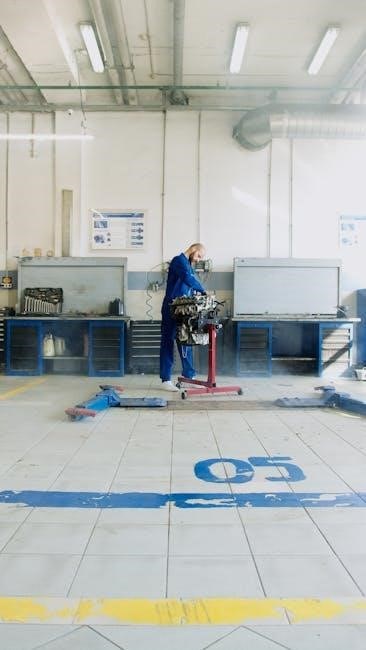A manual transmission van offers a unique driving experience, combining gear-shifting dynamics with practicality․ Ideal for drivers seeking greater control and fuel efficiency, these vans cater to both business needs and enthusiasts․

Benefits of Manual Transmission Vans
Manual transmission vans offer better fuel economy, lower purchase costs, and greater reliability compared to automatics, making them a practical choice for both commercial and personal use․
2․1․ Greater Control and Driving Experience

Manual transmission vans provide drivers with enhanced control over acceleration and deceleration, allowing for a more engaging driving experience․ By manually shifting gears, drivers can optimize speed and torque for various driving conditions, such as uphill climbs or heavy loads․ This level of involvement creates a stronger connection between the driver and the vehicle, making it particularly appealing to enthusiasts․ Additionally, the ability to downshift for engine braking reduces wear on the brakes, especially in hilly or stop-and-go environments․ This precision and responsiveness are why many prefer manual vans for their daily operations or leisure activities, as they offer a sense of mastery and efficiency that automatics often lack․
2․2․ Fuel Efficiency and Cost-Effectiveness
Manual transmission vans are often more fuel-efficient compared to their automatic counterparts, particularly in urban and stop-and-go driving conditions․ This is because manual transmissions typically have fewer power-sapping components, such as torque converters, which are found in automatics․ As a result, drivers can achieve better miles per gallon (MPG), reducing fuel costs over time․ Additionally, manual vans tend to be more cost-effective to purchase upfront, as they are generally priced lower than automatic models․ Maintenance costs are also reduced, as manual transmissions have fewer complex components that require repair or replacement․ For businesses and individuals seeking a practical, economical choice, manual vans offer significant savings without compromising performance․
2․3․Durability and Lower Maintenance Costs
2․3․ Durability and Lower Maintenance Costs
Manual transmission vans are known for their durability and lower maintenance costs compared to automatic models․ With fewer complex components, such as torque converters and sophisticated electronic controls, manual transmissions are less prone to mechanical failure․ This simplicity translates to reduced repair costs over the life of the vehicle․ Additionally, manual vans often require less frequent servicing, as clutches and gearboxes are generally more robust and longer-lasting than automatic transmissions․ This makes them a cost-effective choice for fleet operators and individual owners alike․ Popular models like the Toyota Hiace and Ford Transit have proven their reliability in demanding conditions, further solidifying their reputation for durability․ Overall, manual transmission vans offer a practical, hard-wearing option for those prioritizing longevity and lower upkeep expenses․

Popular Manual Transmission Van Models
Toyota Hiace, Ford Transit, and Mercedes-Benz Sprinter are renowned for their reliability and performance, making them top choices among manual transmission van enthusiasts and commercial users alike․
3․1․ Toyota Hiace
The Toyota Hiace is a highly regarded manual transmission van, celebrated for its durability and versatility․ Equipped with a robust 4․2L diesel engine and a smooth 5-speed manual gearbox, it excels in both commercial and passenger transport roles․ Known for its fuel efficiency and low maintenance costs, the Hiace is a favorite among businesses and drivers seeking reliability․ Its spacious interior and payload capacity make it ideal for cargo and people transport․ Popular in regions like the Philippines, it has become a staple in the manual van market․ Toyota’s commitment to quality ensures the Hiace remains a top choice for those prioritizing performance and practicality; With its proven track record, the Hiace continues to be a reliable workhorse, offering a blend of power and efficiency that meets diverse needs․
3․2․ Ford Transit


The Ford Transit is a top choice among manual transmission vans, offering a blend of power and versatility․ Available with a 5-speed manual gearbox, it is well-suited for both cargo and passenger transport․ The Transit’s durability and fuel efficiency make it a popular option for businesses․ Its robust engine options and smooth gear transitions ensure a seamless driving experience․ Popular models like the Transit Custom and larger Transit variants cater to diverse needs․ While automatic options are available, the manual transmission remains a favorite for its responsiveness and control․ With its proven track record, the Ford Transit is a reliable choice for fleet operators and drivers seeking a practical, hardworking vehicle․ Its widespread use across Europe and beyond underscores its reputation as a dependable manual transmission van․
3․3․ Mercedes-Benz Sprinter
The Mercedes-Benz Sprinter stands out as a premium manual transmission van, renowned for its exceptional performance and versatility․ Available with a 6-speed manual gearbox, it offers precise control and smooth gear transitions․ The Sprinter is highly customizable, catering to both cargo and passenger transport needs․ Its robust engine options, including diesel variants, ensure ample power for heavy-duty tasks․ Additionally, the Sprinter features advanced safety technologies and ergonomic design, enhancing comfort and efficiency․ With its reputation for reliability and durability, the Sprinter is a top choice for businesses requiring a dependable workhorse․ Its popularity spans various industries, making it a leading option in the manual transmission van segment․ The Sprinter’s blend of power, functionality, and refinement solidifies its position as a top-tier choice for both professionals and enthusiasts alike․

The Resurgence of Manual Transmissions in Vans
Manual transmissions are regaining popularity in vans due to a growing demand for driving engagement and a niche market for enthusiasts seeking a more connected experience behind the wheel․
4․1․ Growing Demand for Driving Engagement
The resurgence of manual transmissions in vans is driven by a growing demand for driving engagement and a more immersive experience․ Many drivers prefer the tactile connection of shifting gears, which enhances control and satisfaction․ This trend is particularly evident among enthusiasts who value the thrill of driving and the ability to optimize gear usage for varying conditions․ As automotive technology advances, manual transmissions offer a nostalgic yet practical option for those seeking a more hands-on connection with their vehicle․ This shift reflects a desire to balance modern convenience with the timeless appeal of manual driving, making manual transmission vans a sought-after choice for both personal and commercial use․
4․2․ Niche Market for Enthusiasts
Manual transmission vans have carved out a niche market for driving enthusiasts who prioritize engagement and precision behind the wheel․ These drivers often seek vehicles that offer a more tactile and immersive experience, which automatic transmissions cannot match․ Enthusiasts appreciate the ability to control gear shifts, especially in dynamic driving conditions, and many view manual transmissions as a way to connect more deeply with their vehicle․ This niche demand has led manufacturers to continue offering manual options in select models, catering to a dedicated audience․ While the broader market leans toward automatics, manual vans remain a cherished choice for those who value driving involvement and the satisfaction of mastering a skill․ This niche appeal ensures that manual transmission vans retain a loyal following, even as automation dominates the industry․

Buying Guide for Manual Transmission Vans

Research models like Toyota Hiace or Ford Transit for reliability and performance․ Check fuel efficiency, maintenance costs, and test drive to ensure a smooth shifting experience․
5․1․ Key Features to Consider
When buying a manual transmission van, prioritize features like engine size, transmission type, and drivetrain․ Look for models with proven reliability, such as the Toyota Hiace or Ford Transit․ Consider fuel efficiency, as manual vans often excel in this area․ Payload capacity and cargo space are crucial for business use, while seating arrangements matter for passenger-focused models․ Check the clutch and gearshift mechanism for smooth operation․ Additionally, explore advanced features like driver-assistance technologies or ergonomic interiors․ Test drive to assess gear engagement and overall driving comfort․ Ensure the van meets your specific needs, whether for commercial purposes or personal use․ Research maintenance costs and warranty options to make an informed decision․
5․2․ Test Driving Tips
Test driving a manual transmission van requires attention to detail to ensure it meets your needs․ Start by familiarizing yourself with the clutch and gearshift operation in a safe, open area․ Check for smooth gear transitions and any unusual noises during shifting․ Assess the clutch pedal’s resistance and engagement point to ensure it feels responsive․ Evaluate acceleration and handling, particularly in scenarios like uphill climbs or heavy loads․ Pay attention to seating ergonomics and visibility, as these impact long-term comfort․ If the van is for business use, measure cargo space and test payload capacity․ Avoid rushing the process; take your time to gauge how the van performs in real-world conditions․ A thorough test drive will help you make an informed decision․
5․3․ Maintenance and Repair Tips

Regular maintenance is crucial for extending the lifespan of a manual transmission van․ Always check the transmission fluid level and top it off as needed to ensure smooth gear operation․ Inspect the clutch pedal for proper alignment and adjust it if necessary to prevent uneven wear․ Replace the clutch and gear synchronizers when showing signs of wear, as neglecting these can lead to costly repairs․ Avoid “riding the clutch,” as this can cause excessive heat and damage․ Keep the gearshift lubricated to maintain smooth shifting․ Schedule regular servicing with a professional mechanic familiar with manual transmissions to identify potential issues early․ Address any unusual noises or vibrations promptly, as they often indicate underlying problems․ Proper care ensures optimal performance and minimizes long-term maintenance costs․

